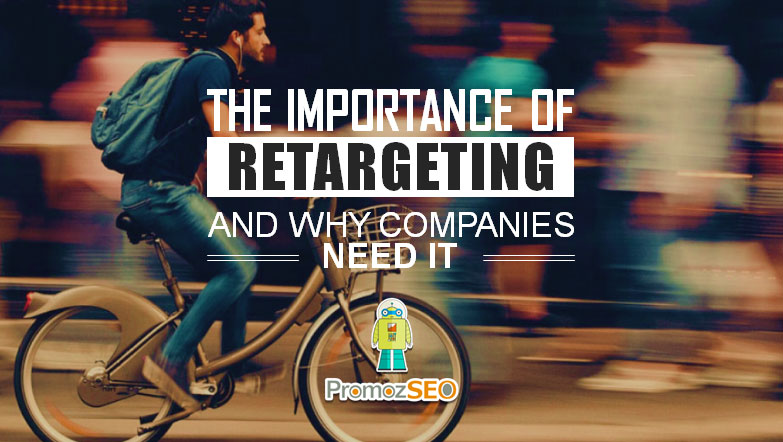The Importance of Retargeting (a.k.a Remarketing) and Why Companies Need It

In the digital era, no serious company underestimates the importance of online marketing. Your competitors are putting a lot of effort into their digital marketing strategies, and so should you.
Since everyone is doing it, the general public has become pretty overwhelmed by the large number of offers coming their way. It should not come as a surprise that only around 2 percent of first-time website visits end up in a purchase.
People have become so easily distracted that they often move on to the next thing, completely forgetting what they were doing and what website they were on and never come back. Many potential customers are also lost forever when they decide to take more time to reconsider making a purchase or wait/look for a better deal.
The question is – how do you prevent this from happening? How do you turn the remaining 98 percent of visits into a purchase? The marketing technique that can help you out in this regard is called retargeting.
Read on and find out more about the importance of retargeting and how your company can benefit from it.
What Is Retargeting And How Does It Work?
It’s not exactly a new technique, but the advancement of technology has given it a whole new life making it one of the most valuable marketing methods in this day and age.
This strategy helps you renew people’s interest in the product or service you are selling through advertising. It is all about targeting a specific group of users – those who have already expressed interest in a certain product/service and re-attracting them.
Of course, a retargeting campaign is always part of a bigger marketing campaign. Retargeting gives the best results when it is combined with advertising and content marketing.
When banners from a website you visited start popping up in other places as if they were following you around the internet, that’s retargeting, a.k.a. remarketing. Retargeting helps you “follow” potential customers as they do other things on the internet and make them come back to your site. In other words, you monitor your customer’s behavior and utilize that information to pull them back to your website.
When someone visits a website, and it puts a cookie in their computer, the website is able to identify the visitor wherever they go from that moment (as creepy as it may sound). The ads for the site they visited will appear everywhere, usually on search engines and social media.
For example, if someone visits your site and views your products but later on leaves it without making a purchase, the retargeting ads will serve as a reminder that your offer still exists. Perhaps they will be happy to see your offer again. Or, if they do buy something, but the product requires refills or replacements, the buyer will be reminded that they can count on you.
Is Retargeting Legal?
It is no secret that most internet users are concerned about their privacy. Retargeting may sound like a major invasion of privacy. It may even sound illegal. However, it does not go against any law, provided that you have a clear privacy policy, of course. The way you collect and utilize people’s data, including cookies, has to be clearly stated.
Side note: Online privacy policy generators
The Importance of Retargeting and Its Key Benefits
Pretty much any company interested in stepping up its digital marketing efforts and increasing sales should acknowledge the importance of retargeting.
Your company should not just rely on new visitors to increase sales. Research shows that new visitors seldom purchase anything valuable. They are much more likely to just look around and abandon your site. But, the more often a potential customer sees an offer, the more they’re driven to proceed with the purchase. All they need is a gentle push in the right direction. That’s why all companies, no matter how big or small, need several online marketing tools to help them persuade potential buyers. And retargeting ads are a great way to do that.
Statistics show that retargeting ads actually get 76 percent more clicks than regular ads. With a successful retargeting campaign combined with other marketing strategies, you can drastically increase e-commerce traffic and drive online sales, which is something most companies strive for.
As mentioned, the main idea is targeting people who have already shown interest in your product/service, reinstating that interest, and converting them to buyers. Someone who has already browsed your site is much more likely to become a buyer, and when they do, they are more likely to become a regular buyer and recommend your brand to others.
We’re not saying one-size-fits-all messaging can’t be effective. However, retargeting can be a much better strategy because it is much more tailored and personal. Moreover, it opens the door for a variety of other marketing campaigns. That’s how important retargeting is for your overall marketing success.
Retargeting is an excellent way to achieve greater marketing ROI. However, implementing it requires some skill. Still, with sufficient experience and practice, you will be able to implement the right remarketing tactic and reap the benefits. Once you find the best way to attract clients back to your site to complete the purchase, all efforts will be worth it.
Common Retargeting Strategies
Using a retargeting pixel and a retargeting list are the two most common retargeting methods. Other common methods include social media retargeting, using mobile apps, and search engine retargeting.
Here are some effective retargeting strategies you should know about.
Pixel-Based Retargeting
This retargeting strategy uses cookies to encourage further conversion based on individuals’ previous behavior. It enables companies to show their ads to any anonymous visitor who visits their site. In this method, when a person visits your website, a piece of JavaScript (a pixel) is put in their browser. That means the visitor’s browser is now cookied. The browser cookie, later on, notifies the retargeting platforms to display specific ads depending on the pages the visitor viewed on your company’s site. By later, we mean very soon, as soon as a visitor abandons your company’s website. This way, you can remind them of the offer they were viewing immediately after leaving your site.
Pixel-based retargeting is not without its flaws, though. Since this strategy is directly linked to the traffic and visitor behavior on your site, if there is no traffic, you cannot show your ads.
Social Media Retargeting
No one can deny the importance of social media marketing in the 21st century. The world of social media offers numerous marketing opportunities you should not miss out on.
This is a sub-category of pixel-based retargeting, which works in a similar way. It also enables you to show ads to your website visitors and/or the individuals who have interacted with your posts on social networks. Such interactions include shares, comments, and likes. The most popular social media platforms you can use for social media retargeting include Facebook, Twitter, Instagram, Pinterest, Snapchat, and LinkedIn.
List-Based Retargeting
This strategy may not be as common as pixel-based retargeting, but it definitely has its perks. It allows you to have highly customizable criteria for your ads, which can result in much higher conversions.
List-based retargeting uses email addresses on your current mailing list to target potential customers. Once you gather your audience’s contact information, you need to upload a list of addresses to a retargeting campaign and you get to choose who goes on which list. The platforms commonly used for this type or retargeting are Twitter and Facebook. Then, the platform identifies users with those email addresses and sends them your ads.
Your mailing list has to be pretty large if you want to succeed with this strategy. The problem is, if the email address on the social network and the address the person gave you do not match, you won’t be able to display your ads. Unfortunately, the match rates can be as low as 20 to 30 percent for some social media platforms.
Furthermore, list-based retargeting is less automatic and timely compared to pixel-based retargeting, since you are the one who does the uploading and maintains the list.
Onsite Retargeting
Some retargeting strategies are not about pulling visitors back to your website. The approach known as onsite retargeting helps you keep visitors on your site for longer.
It is all about convincing the visitor to make a purchase instead of going somewhere else. The main benefits of onsite retargeting are re-engaging visitors, converting them into leads, building your email list, and boosting sales.
This tactic is also highly personalized and it focuses on previous behavior. It enables you to follow visitors while they are on your site and sense when new content (popups, ads, etc.) is needed to re-engage them and keep them from leaving. Tracking algorithms detect certain behaviors, such as inactivity and mouse movements, which enables you to predict when a visitor needs some sort of stimulation and react accordingly before they leave.
Search Retargeting
Another way to retarget your audience is going after people who use terms relevant to your business in their searches. Search retargeting enables you to display ads only to people who have searched for a certain keyword or phrase.
Note that this form of retargeting relies on assumptions about the person’s intent. The fact that someone has used keywords or phrases relevant to your business does not always mean they have the slightest intention of making a purchase. So, make sure you consider what the searcher’s intention is before bombarding them with your ads.
How to Avoid Common Retargeting Mistakes
Now that we’ve emphasized the importance of retargeting multiple times, we want to talk briefly about retargeting done wrong.
We all know how annoying online ads can be. No one wants to be bombarded with ads even if they are interested in buying, let alone after they have already bought it or decided not to buy. Your target audience may become so frustrated that they decide against making a purchase or start avoiding your brand altogether simply because you’re being pushy.
Here are a few tips on how to advertise your brand without going overboard and alienating potential buyers:
- Divide your target audience into smaller segments or groups. The idea here is to tailor the ads specifically for each group.
- We have already mentioned how annoying it is when you see a product ad, which you’ve already bought, over and over again. This is both frustrating and unnecessary. So, instead of pushing the same exact product, try with something similar or related to it. Perhaps something that complements the product they already own.
- Instead of linking to your site’s homepage, link directly to the page with the product people are looking for. Making customers look for that page themselves adds an unnecessary step. On the other hand, leading a potential customer straight to the page where they can find the product they want increases your chances of selling.
Wrapping Up
So now that you know why retargeting is important in online marketing and its different types let us know how you are planning to incorporate it into your digital marketing plan.
Or do you already use retargeting? What is your experience in that case? How do you implement, monitor, and improvise the retargeting techniques? We would like to know them all.
Comment down below and let us know if you have any questions related to retargeting, a.k.a remarketing. We will be happy to help you do it correctly and get the best possible return on investment.
About the Author
Sophia Bowe is a freelance writer from Brooklyn, New York. Over the past decade, she has been sharing her knowledge and experience in topics related to digital marketing. In her ten years of experience, Sophia has written blogs for several companies, mostly from the field of marketing. In her spare time, she enjoys reading and writing fiction.
An advanced All-in-One Digital Marketing Course.
Mentored by Mr. Soumya Roy, the Founder, CEO of PromozSEO Web Marketing Academy.
- Reasons Your Business Needs to be on Instagram - September 16, 2021
- 7 Reasons Your Business Should Invest in Professional Content Creation - August 12, 2021
- 5 Ways You Can Improve Your Website’s Existing Backlinks - April 30, 2021








